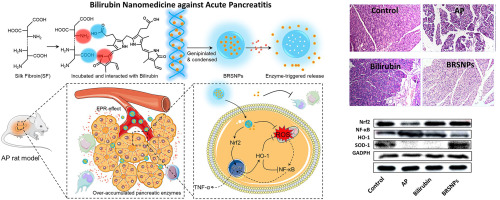当前位置:
X-MOL 学术
›
J. Control. Release
›
论文详情
Our official English website, www.x-mol.net, welcomes your
feedback! (Note: you will need to create a separate account there.)
Protective effects and mechanisms of bilirubin nanomedicine against acute pancreatitis.
Journal of Controlled Release ( IF 10.5 ) Pub Date : 2020-04-01 , DOI: 10.1016/j.jconrel.2020.03.034 Qing Yao 1 , Xue Jiang 1 , Yuan-Yuan Zhai 1 , Lan-Zi Luo 1 , He-Lin Xu 1 , Jian Xiao 1 , Longfa Kou 2 , Ying-Zheng Zhao 1
Journal of Controlled Release ( IF 10.5 ) Pub Date : 2020-04-01 , DOI: 10.1016/j.jconrel.2020.03.034 Qing Yao 1 , Xue Jiang 1 , Yuan-Yuan Zhai 1 , Lan-Zi Luo 1 , He-Lin Xu 1 , Jian Xiao 1 , Longfa Kou 2 , Ying-Zheng Zhao 1
Affiliation

|
Acute pancreatitis (AP) is a sudden inflammatory reaction, caused by the activation of pancreatic enzymes in the pancreas, and in severe cases can lead to systemic inflammation and multiple organ failure. Oxidative stress contributed to the further deterioration of inflammation and played an important role in AP development. Bilirubin has been found to exert antioxidative, anti-inflammatory, and anti-apoptotic effects in a series of diseases accompanied by a high level of oxidative stress. However, the therapeutic effects of bilirubin for AP management have not yet been demonstrated. Additionally, the poor solubility and potential toxicity of bilirubin also limit its application. Thus, we developed bilirubin encapsulated silk fibrin nanoparticles (BRSNPs) to study the protective effects and mechanisms of bilirubin nanomedicine for the treatment of AP. BRSNPs could selectively delivery to the inflammatory lesion of the pancreas and release bilirubin in an enzyme-responsive manner. In the model of AP caused by L-Arginine hyperstimulation, BRSNPs exerted strong therapeutic effects against AP by the reduction of oxidative stress, decreased expression of pro-inflammatory cytokines, and impaired recruitment of macrophages and neutrophils. The mechanism study indicated that BRSNPs protected acinar cells against extensive oxidative damage and inflammation through inhibiting NF-κB pathway and activating the Nrf2/HO-1 pathway. Collectively, for the first time, this study demonstrated that bilirubin nanomedicine, BRSNPs, are effective in alleviating experimental acute pancreatitis, and the mechanisms are associated with its inhibition of NF-κB regulated pro-inflammatory signaling and activation of Nrf2-regulated cytoprotective protein expression.
中文翻译:

胆红素纳米药物对急性胰腺炎的保护作用及其机制。
急性胰腺炎(AP)是一种突然的炎症反应,由胰腺中胰腺酶的激活引起,在严重的情况下可能导致全身性炎症和多器官功能衰竭。氧化应激导致炎症进一步恶化,并在AP的发展中发挥重要作用。已经发现胆红素在伴随高水平氧化应激的一系列疾病中发挥抗氧化,抗炎和抗凋亡的作用。然而,胆红素对AP治疗的治疗作用尚未得到证实。另外,胆红素的不良溶解性和潜在毒性也限制了其应用。从而,我们开发了胆红素包封的丝纤维蛋白纳米粒子(BRSNPs),以研究胆红素纳米药物对AP的保护作用和机制。BRSNP可以选择性地递送至胰腺的炎性病变并以酶反应方式释放胆红素。在由L-精氨酸过度刺激引起的AP模型中,BRSNPs通过降低氧化应激,减少促炎性细胞因子的表达以及削弱巨噬细胞和嗜中性白细胞的募集,对AP发挥强大的治疗作用。机制研究表明,BRSNPs通过抑制NF-κB通路和激活Nrf2 / HO-1通路来保护腺泡细胞免受广泛的氧化损伤和炎症。总的来说,这项研究首次证明了胆红素纳米药物BRSNP,
更新日期:2020-04-01
中文翻译:

胆红素纳米药物对急性胰腺炎的保护作用及其机制。
急性胰腺炎(AP)是一种突然的炎症反应,由胰腺中胰腺酶的激活引起,在严重的情况下可能导致全身性炎症和多器官功能衰竭。氧化应激导致炎症进一步恶化,并在AP的发展中发挥重要作用。已经发现胆红素在伴随高水平氧化应激的一系列疾病中发挥抗氧化,抗炎和抗凋亡的作用。然而,胆红素对AP治疗的治疗作用尚未得到证实。另外,胆红素的不良溶解性和潜在毒性也限制了其应用。从而,我们开发了胆红素包封的丝纤维蛋白纳米粒子(BRSNPs),以研究胆红素纳米药物对AP的保护作用和机制。BRSNP可以选择性地递送至胰腺的炎性病变并以酶反应方式释放胆红素。在由L-精氨酸过度刺激引起的AP模型中,BRSNPs通过降低氧化应激,减少促炎性细胞因子的表达以及削弱巨噬细胞和嗜中性白细胞的募集,对AP发挥强大的治疗作用。机制研究表明,BRSNPs通过抑制NF-κB通路和激活Nrf2 / HO-1通路来保护腺泡细胞免受广泛的氧化损伤和炎症。总的来说,这项研究首次证明了胆红素纳米药物BRSNP,











































 京公网安备 11010802027423号
京公网安备 11010802027423号